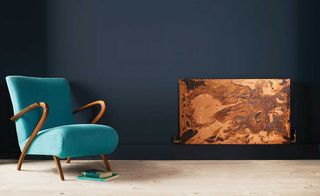选择发射器:地板下供暖与散热器s
Struggling to choose between underfloor heating and radiators for your home? Then read our guide to the pros and cons of both

Your choice of heating emitter will dictate the way in which heat is distributed and, crucially, how you experience it in your home. What’s more, choosing betweenunderfloor heatingand radiators is often the starting point for choosing a new heating system for a self build or renovation project.
There are three main options:
- Underfloor heating (UFH)now tends to be the emitter of choice for many self builders and renovators, for the comfort, efficiency and the extra wall space it gives.
- Radiatorsare cheaper than UFH and choice is as much about aesthetics as it is by the amount of heat needed.
- Skirting board heatersare not yet as popular as we might have expected 10 years ago, but they do have a lot to offer, especially in retrofit projects, being something of a halfway-house between UFH and radiators.
Choosing Underfloor Heating
Underfloor heating offers an effective, efficient heating medium that’s out of sight and makes no demands on wall space.
It works by effectively turning the entire floor area into a radiator, via warm water pipes (wet UFH) or electric mats concealed within the floor structure.(We will be looking at wet UFH for the purposes of this article.)热水管道通常是嵌入在一个screed. But there are other methods of installation, particularly for renovators.
The resulting gentle heat (due to the floor’s large surface area, it only needs to be a couple of degrees warmer than room temperature,) rises steadily upwards, and there are no cold spots or draughts, making for a very comfortable environment.
To add to that, underfloor heating is the perfect partner to aheat pump, which is effective at producing the low temperature required.

This is the time taken for the heating system to bring the room to the desired temperature and to cool down again.
You will need to decide how to run the system (your required reaction time), which is largely determined by the thickness of the screed:
- Athick screedwill give a long reaction time, especially if the UFH pipes are housed in the concrete slab. With a reaction time of over four hours, it is best to run the UFH system 24 hours per day. The system would be run at a lower room temperature – say 15°C or 16°C – to provide background heating to the whole house, with highlight heating (i.e. a woodburning stove) in the rooms that are actually occupied
- With athin screed and a reaction time of around 30 minutes, the system can be run in a similar way to a radiator system
Pros
- UFH operates at lower temperatures than radiators, making itmore efficient
- It can be paired withrenewable technology. As UFH does not need high water temperatures to operate, it is particularlywell-suited to heat pumps
- Underfloor heatingfrees up wall space, giving greater flexibility with regards to where to place of furniture
- Concealed within the floor, UFH does not have an impact on the interior design of the house
- It distributes an even heat throughout the room/space, meaningno cold spots —making for a very comfortable living environment
Cons
- It isnot instantaneous(depending on the set up) as radiators, and could take a couple of hours to heat the room up; although conversely radiators also cool down faster
- The floor finish needs some consideration
- An UFH system arguably requires more planning and needs to be properly installed to ensure it runs at optimum efficiency
- An UFH system will typicallycost moreto specify and install
Choosing Radiators
The advantage of radiators is that they are quick to warm up and easy to control, particularly with the new breed of smart valves.
“Thermostatic radiator valves (TRVs) are now ubiquitous, but think about digital programmable valves instead,” says energy efficiency expert Tim Pullen. “There are lots to choose from at around £25 each, and they really do reduce your heating bill by only heating rooms when and to what temperature you want.”

The size of a radiator will depend on a number of factors, including:
- The dimensions of the room/space
- The number of doors or windows
- The insulation levels and presence of external walls
Size is calculated in BTUs (British Thermal Units). A heating engineer or plumber will work it out for you or you can use anonline heat output calculator.
“All radiators have a specified heat output so once you know how much heat the room needs you can choose the type, size and style to suit your taste and the room,” says Tim Pullen.
Pros
- Radiators arequick to respondto desired changes in temperature
- Radiators are a familiar option and well understood by almost all heating engineers and plumbers
- 他们是cheaper to install
- Radiators are comparatively less disruptive to install in existing homes than UFH
Cons
- Radiators do not distribute an even heat throughout the room, and canresult in cool spots
- They cool down quicker than UFH
- 他们是less efficient
- Theytake up wall space, which can provide less scope for window/door placement and furniture layout, and be particularly problematic in smaller homes
- Cheap radiators can distract from the aesthetic of a room
Skirting Heating
Doing away with radiators and cheaper than underfloor heating, skirting heating has the external appearance of regular skirting boards but conceals pipework or electrical elements.
It distributes gentle, even heat at a low temperature with minimal air movement. Unlike underfloor heating, skirting heating can be turned on and off to suit as its responsiveness is more akin to radiators.
For more information, visitthermaskirt.com.
Get the Homebuilding & Renovating Newsletter
Bring your dream home to life with expert advice, how-to guides and design inspiration, direct to your inbox.
Claire is Editor in Chief of Homebuilding & Renovating website and magazine. She became Editor of Homebuilding & Renovating in 2016 and has been a member of the team for 15 years. An experienced homes journalist, her work has also appeared in titles such as Real Homes and Period Living.
She has a particular interest in green homes and sustainability, and interior design is a passion too; she has undertaken qualifications in this area.
After finishing a major renovation of a period cottage, she is now onto her next project: overhauling a 1930s property in the Shropshire countryside.
Most Popular
Bring your dream home to life with expert advice, how-to guides and design inspiration, direct to your inbox.
Thank you for signing up to Homebuilding. You will receive a verification email shortly.
There was a problem. Please refresh the page and try again.

